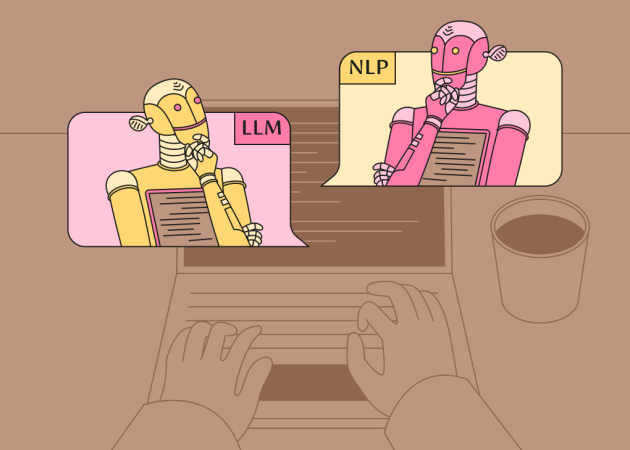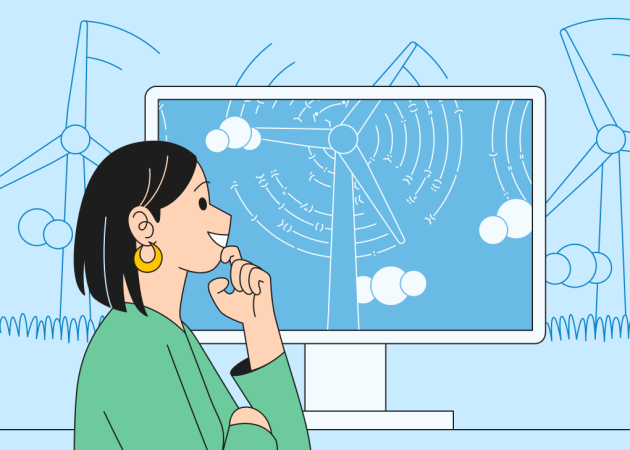
IoT in Clean Energy Tech: Transforming Sustainability Through Connectivity
Contents
Contents
Clean energy technologies are one of the key pillars in achieving global sustainability goals. The development of innovative green software solutions plays a crucial role in supporting these goals through advanced technologies. The Internet of Things (IoT) in the energy industry refers to a gamut of connected smart devices that merge energy production, distribution, and consumption into a unified system. This connectivity helps improve the efficiency of energy networks from generation to end use while reducing resource waste.
The global IoT market in the energy sector is estimated to grow to about US$59.4 billion by 2030. Advancements in sensor technology, the convergence of embedded systems, machine learning, and AI have further increased IoT’s value for clean energy, allowing energy companies to collect detailed real-time data from power grids, wind turbines, and solar panels. Without further ado, let’s explore the role of IoT in clean energy technology in more detail, as well as its advancements and the challenges that lie ahead.
The Role of the Internet of Things in the Energy Sector
The growing energy demand from industries such as transportation, ICT, and household appliances puts increasing pressure on the energy sector. IoT solutions play a vital role in addressing these challenges by enabling utilities to operate power grids during extreme events, such as severe weather or natural disasters, ensuring system resilience.
Renewable energy sources, while critical for sustainability, introduce variability into energy systems due to their intermittent nature. IoT technologies mitigate these challenges by facilitating forecasting, predictive maintenance, and seamless integration of renewables into existing energy grids. This creates a bridge between conventional power grids and renewable energy generation, optimizing energy use and reducing carbon emissions.
Key Applications of IoT in Clean Energy
Grid optimization and smart grids
Smart grids represent a new generation of energy grids that leverage digital technologies to improve efficiency, reliability, and resilience. Unlike conventional grids, smart grids equipped with IoT-enabled sensors and controllers provide real-time data on energy flow. This helps operators dynamically balance supply and demand, minimizing energy losses and improving system reliability. Advantages include:
- Fault detection and recovery: IoT applications detect system faults, reconfigure energy flows, and restore power to unaffected areas without requiring manual intervention. These features significantly reduce downtime, especially during critical situations.
- Localized microgrid structure: Smart grids often operate with a microgrid configuration, supplying electricity to small communities while remaining connected to a larger energy network. The economic value of microgrids is that they avert productivity and inventory losses during power outages. As local energy plants, they create and retain new jobs within the community and attract high-quality employees.
- Bi-directional energy and data flow: IoT technologies in smart grids allow for two-way electricity and data exchange, supporting a more dynamic and diversified energy market. For instance, homes with solar panels can generate electricity for their use and sell excess energy back to the grid, both cutting their reliance on fossil fuels and promoting the adoption of renewable energy.
- Enhanced renewable energy integration: Smart grids are particularly suited for renewable energy sources like solar and wind. IoT systems allow operators to monitor and manage these energy sources in real-time, ensuring grid stability even with variable energy inputs.
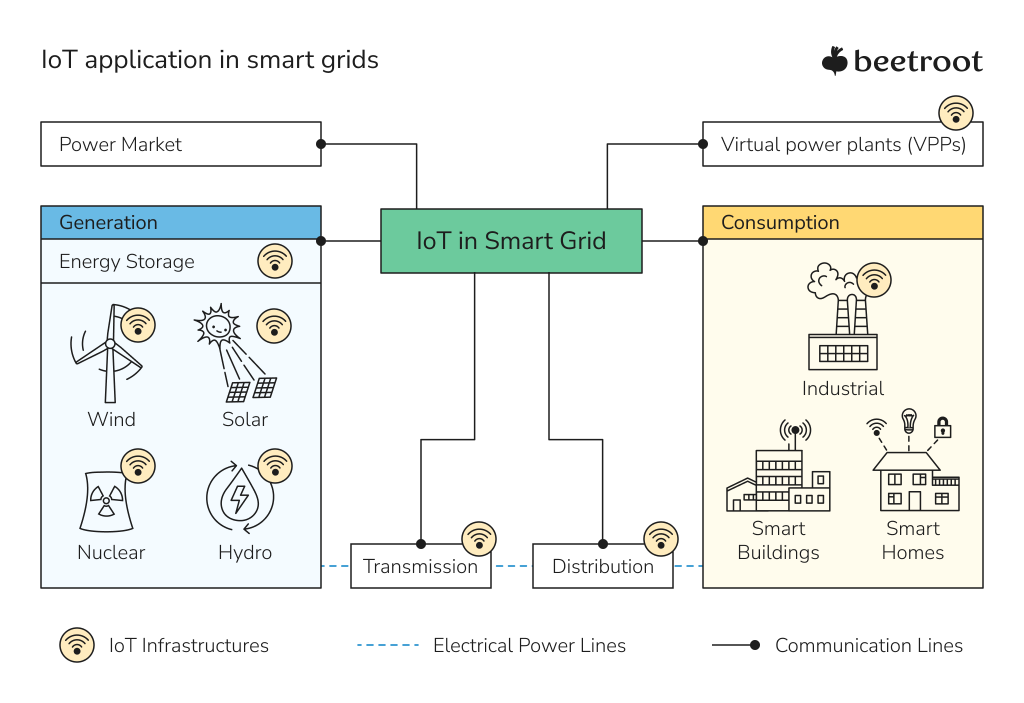
However, despite their advantages, the widespread adoption of smart grids still faces challenges. Integrating diverse sensors, controllers, and digital technologies into a cohesive system is complex. Ensuring interoperability and normalizing the data received from these devices are key hurdles that require expertise in IoT development and energy management systems.
Decentralized energy management
Decentralized energy management leverages IoT technologies to monitor, predict, and optimize the performance of localized renewable energy units like solar panels, wind turbines, and microgrids, improving the overall efficiency and reliability of the energy network. Key elements include:
- Predictive maintenance: IoT devices can identify potential equipment failures before they occur, reducing downtime and maintenance costs. Additionally, self-healing mechanisms in IoT-enabled smart grids automatically bypass damaged nodes, ensuring rapid recovery and reducing service interruptions.
- Grid monitoring and accident prevention: IoT sensors installed in energy grids assess the condition of their components in real-time. By identifying vulnerabilities or imbalances, such as those caused by natural disasters or supply-demand mismatches, IoT systems can prevent severe damage to power plants and major blackouts.
- Enhanced communication and coordination: IoT facilitates accurate communication between power stations, key network nodes, and the grid. Data-driven algorithms analyze energy consumption and grid conditions, creating predictive models to anticipate potential issues, such as natural disasters or equipment failures.
- Proactive load management: Predictive models and real-time alerts enable utilities to manage energy consumption during critical events. For example, consumers can be notified about potential grid vulnerabilities and encouraged to reduce electricity usage, easing the load on weak nodes and contributing to grid stability.
By integrating IoT into decentralized energy management, energy systems become more adaptable and resilient. This approach not only supports the integration of renewable energy sources but also ensures the sustainability and reliability of the entire energy infrastructure.

Energy demand forecasting and efficiency optimization
IoT technologies play a crucial role in forecasting energy demand and optimizing energy usage, enabling more efficient and sustainable energy consumption. By integrating connected devices, smart meters, and automation systems, IoT provides a comprehensive approach to managing energy demand while reducing waste and costs:
- Energy demand forecasting: IoT systems analyze energy consumption patterns, weather conditions, and market trends to predict future demand. This allows utilities to adjust energy production proactively, ensuring a stable supply-demand balance and minimizing the risk of overloading the grid.
- Energy efficiency monitoring: IoT-enabled devices in homes, buildings, and factories continuously monitor energy usage to identify inefficiencies. These insights help users implement energy-saving measures and optimize consumption, reducing overall energy costs and environmental impact.
- Automation of energy usage: IoT-based home automation systems and smart meters enable intelligent energy management. For instance, users can automate energy-consuming devices, such as fans or appliances, to turn off during high-demand periods and resume operation when demand subsides.
- Seamless smart meter integration: IoT solutions eliminate the need for manual meter readings by automating data collection and communication with electricity providers. Smart meters equipped with IoT capabilities provide real-time updates, ensuring accurate billing and efficient energy distribution.

By combining demand forecasting with automated energy management and efficiency monitoring, IoT helps create smarter energy systems. In fact, implementing IoT in energy networks can improve efficiency by 20-30%, according to the International Energy Agency. As the technology advances, we can expand the innovative applications of IoT to:
- Smart energy storage: IoT sensors enhance the performance of battery systems by monitoring parameters like charge cycles, temperature, and capacity, ensuring optimal use and longevity.
- EV integration: IoT-enabled electric vehicle (EV) charging networks optimize grid interactions, balancing charging times with peak energy production periods from renewable sources.
- Renewable energy trading: IoT enables peer-to-peer energy trading platforms where individuals or small businesses can sell excess energy generated within a local community.
These advancements collectively position IoT as a linchpin in achieving sustainable energy transitions, making it a cornerstone for innovation in the clean energy sector.
IoT Advancements in Environmental Monitoring
A study by Allied Market Research estimates that the IoT-enabled environmental monitoring market will grow at an 8.2% compound annual growth rate (CAGR), reaching US$43.5 billion by 2030. This growth reflects the increasing reliance on IoT devices to deliver precise, real-time data that supports better decision-making in environmental and energy management.
Current IoT environmental monitoring applications
Environmental monitoring powered by IoT spans multiple domains, each contributing to minimizing ecological disruption and maximizing the efficiency of clean energy systems:
- Air quality sensors: Advanced IoT sensors continuously track pollutants emitted by energy facilities, providing actionable data to control emissions and comply with environmental standards. For example, they can identify spikes in carbon emissions and trigger automatic adjustments in operational processes to mitigate environmental impact.
- Water management systems: IIoT technologies are vital in hydropower facilities and in monitoring water levels, flow rates, and consumption patterns to maintain ecological balance. Additionally, in agriculture-linked clean energy projects, IoT-enabled water monitors optimize irrigation processes, improving energy efficiency and resource sustainability.
- Soil condition monitors: Solar farms and bioenergy production sites rely on IoT devices to analyze soil moisture, nutrient levels, and temperature. These insights guide infrastructure placement, such as solar panels, to maximize energy generation while minimizing land degradation.

Emerging trends in IoT for environmental monitoring
The evolution of IoT technologies is further enhancing their capabilities in environmental monitoring, particularly for clean energy applications:
- Integration with AI: Combining IoT with artificial intelligence enables predictive analytics, helping stakeholders anticipate and respond to challenges like resource shortages or the impacts of extreme weather on energy infrastructure.
- Remote monitoring: IoT devices equipped with advanced communication protocols, such as LPWAN (Low-Power Wide-Area Network), make it possible to monitor remote or hard-to-reach locations. This is particularly valuable for offshore wind farms and isolated hydropower plants.
- Real-time alerts: IoT systems provide immediate alerts for environmental anomalies, such as unexpected increases in pollutants or critical changes in water flow. These instant notifications allow for timely corrective actions, ensuring smooth energy production and reducing risks.
By seamlessly integrating real-time data collection, predictive analytics, and remote monitoring, IoT is becoming indispensable for clean energy stakeholders. These technologies enhance environmental monitoring and ensure scalability and sustainability, addressing the needs of a rapidly evolving energy landscape.

Internet of Things and Clean Energy Production
IoT integration can enhance the efficiency of renewable energy systems by up to 35% (IRENA), driving significant cost savings and environmental benefits. IoT optimizes renewable energy production by providing real-time performance data, predictive analytics, and operational efficiency across various sectors. By enabling smarter operations and resource allocation, IoT is transforming how clean energy systems are deployed and maintained. The sector-specific applications include:
IoT in solar energy
IoT systems integrate smart inverters and trackers that dynamically adjust solar panels to capture maximum sunlight, even in fluctuating weather conditions. They also monitor performance metrics such as voltage, current, and temperature to ensure optimal energy output and prolong equipment lifespan. Advanced IoT systems enable remote diagnostics, allowing technicians to address potential issues without on-site visits.
IoT in wind energy
IoT-enabled sensors on wind turbines measure wind speed, direction, vibration, and temperature. This data is analyzed in real-time to adjust blade angles for maximum efficiency. Predictive maintenance tools reduce downtime by detecting early signs of wear or failure in turbine components, which is crucial for offshore wind farms where maintenance costs are higher.
IoT in hydropower
IoT applications in hydropower include regulating water flow, monitoring turbine efficiency, and ensuring dam safety. These systems optimize energy production while maintaining ecological balance by adjusting water release schedules based on environmental conditions and energy demand.
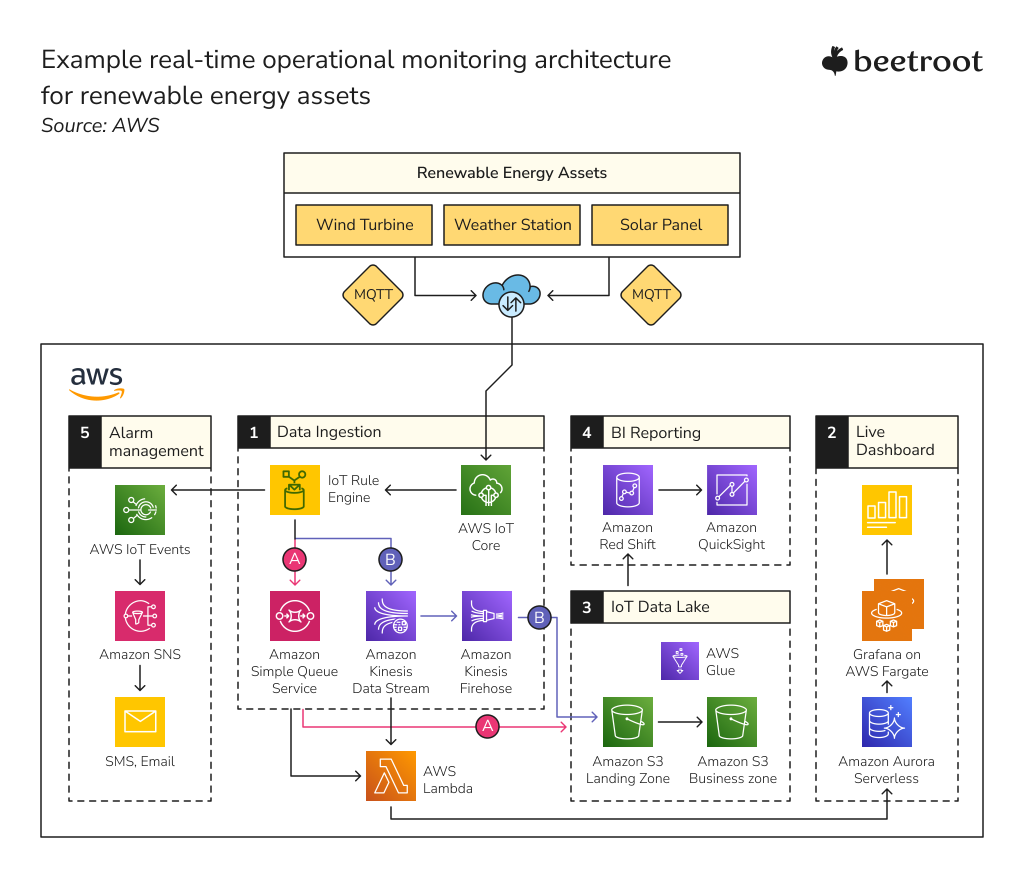
Real-time operational monitoring is essential for maximizing the benefits of IoT in renewable energy production. Cloud technology services, for example, those offered by AWS IoT, play a central role here. Whether it’s monitoring solar panel metrics, turbine efficiency, or even water flow in hydropower systems, cloud platforms provide the scalable infrastructure necessary to underpin smarter operations and predictive analytics that drive reliability and efficiency in the clean energy industry. The infographic above depicts an example of an AWS-powered IoT architecture for renewable generation assets.
IoT in Resource Management
Efficient resource management is critical for sustainable energy solutions. IoT provides innovative approaches to monitor, optimize, and conserve energy resources while improving overall operational efficiency. The adoption of IoT in resource management is projected to reduce energy waste by up to 30%, according to the World Economic Forum. The integration of IoT into resource management strategies addresses some of the most pressing challenges in clean energy systems. Key applications of IoT in resource management include:
- Smart metering: IoT-enabled smart meters collect and transmit real-time data on energy usage, enabling consumers and businesses to track their consumption patterns. This empowers users to identify inefficiencies, adopt energy-saving practices, and reduce costs. For utility providers, it facilitates accurate billing and demand forecasting.
- Demand response systems: IoT plays a crucial role in balancing energy supply and demand. By monitoring grid conditions and user consumption, IoT devices can automate demand response actions, such as reducing power to non-essential systems during peak times. This ensures grid stability and prevents energy shortages.
- Energy storage optimization: IoT sensors monitor battery systems in renewable energy setups, tracking charge-discharge cycles, temperature, and capacity. By analyzing this data, IoT systems predict optimal charging times and prevent overloading, extending battery lifespan and improving storage efficiency.
- Water-energy nexus management: In hydropower and agriculture-linked energy projects, IoT devices optimize water use, ensuring sustainable energy production. For instance, sensors can adjust irrigation schedules to reduce water wastage while maintaining energy generation efficiency.
- Resource allocation in microgrids: IoT technologies enable dynamic resource allocation within microgrids by monitoring distributed energy resources and prioritizing their utilization based on demand and availability. This ensures efficient and equitable energy distribution.
By integrating these applications, IoT enhances the effectiveness of resource management systems, fostering sustainable practices and supporting the clean energy transition.
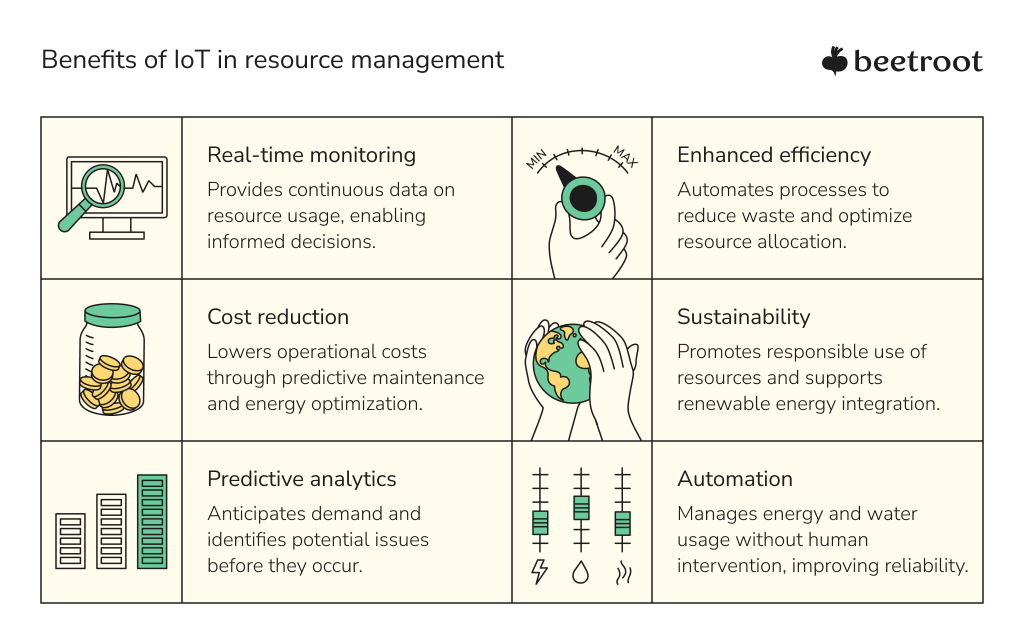
Challenges and Future Prospects of IoT in Clean Energy Technology
While IoT holds immense promise for clean energy systems, its widespread adoption faces several challenges. Addressing these obstacles is crucial to unlocking its full potential and driving innovation in the clean energy sector. Primary concerns can be summarized as follows:
Data security and privacy
The interconnected nature of IoT systems exposes them to potential cyberattacks, which could compromise sensitive information or disrupt operations. Ensuring robust cybersecurity involves implementing strong encryption for data transmission, conducting regular system updates to counter new threats, and segmenting networks to protect critical systems.
High cost of infrastructure and deployment
Setting up IoT systems requires substantial investment in hardware, software, and connectivity solutions, particularly in remote or large-scale energy setups. For smaller energy providers, these costs can be prohibitive. Additional expenses arise from the need to establish communication networks in areas with limited connectivity and maintain durable hardware for harsh environmental conditions. Developing cost-effective solutions and scalable business models is essential to address this issue.
Interoperability issues
Many IoT devices are designed using proprietary protocols, which complicates their integration with devices from other manufacturers. This lack of standardization creates challenges in ensuring seamless communication and operation across platforms. Collaborative efforts to establish universal communication protocols are needed to simplify integration and encourage broader adoption.
Scalability concerns
As the number of IoT devices grows, scalability concerns become increasingly prominent. Energy systems must handle higher data traffic without performance degradation. Network congestion and latency can impede real-time decision-making, making advanced solutions like edge computing and improved data processing architectures critical for managing these challenges.
Regulation and compliance
Regulatory hurdles add complexity to the deployment of IoT in clean energy. The regulatory landscape is often fragmented and continuously evolving. Organizations must navigate data protection laws, such as GDPR or CCPA, while also adhering to region-specific energy and environmental standards. Compliance efforts require significant resources, and delays in adapting to new regulations can slow down implementation.
Despite these challenges, the future of IoT in clean energy is promising, as it has already transformed the industry. Technological advancements, such as AI-driven threat detection for cybersecurity, more cost-efficient hardware, and standardized protocols, will further address many existing barriers. Additionally, the integration of advanced AI, edge computing, and 5G networks will enhance system scalability and reliability. Collaborative efforts between governments, energy providers, and technology companies will also help streamline regulations and facilitate broader and faster deployment. As GreenTech and CleanTech companies seek to achieve greater impact, partnering with experienced software development teams is critical to harness IoT’s potential for the greater good. If this resonates with your organization’s goals, reach out to Beetroot to see how we can help you reach new heights in your sustainability journey.
Subscribe to blog updates
Get the best new articles in your inbox. Get the lastest content first.
Recent articles from our magazine
Contact Us
Find out how we can help extend your tech team for sustainable growth.


